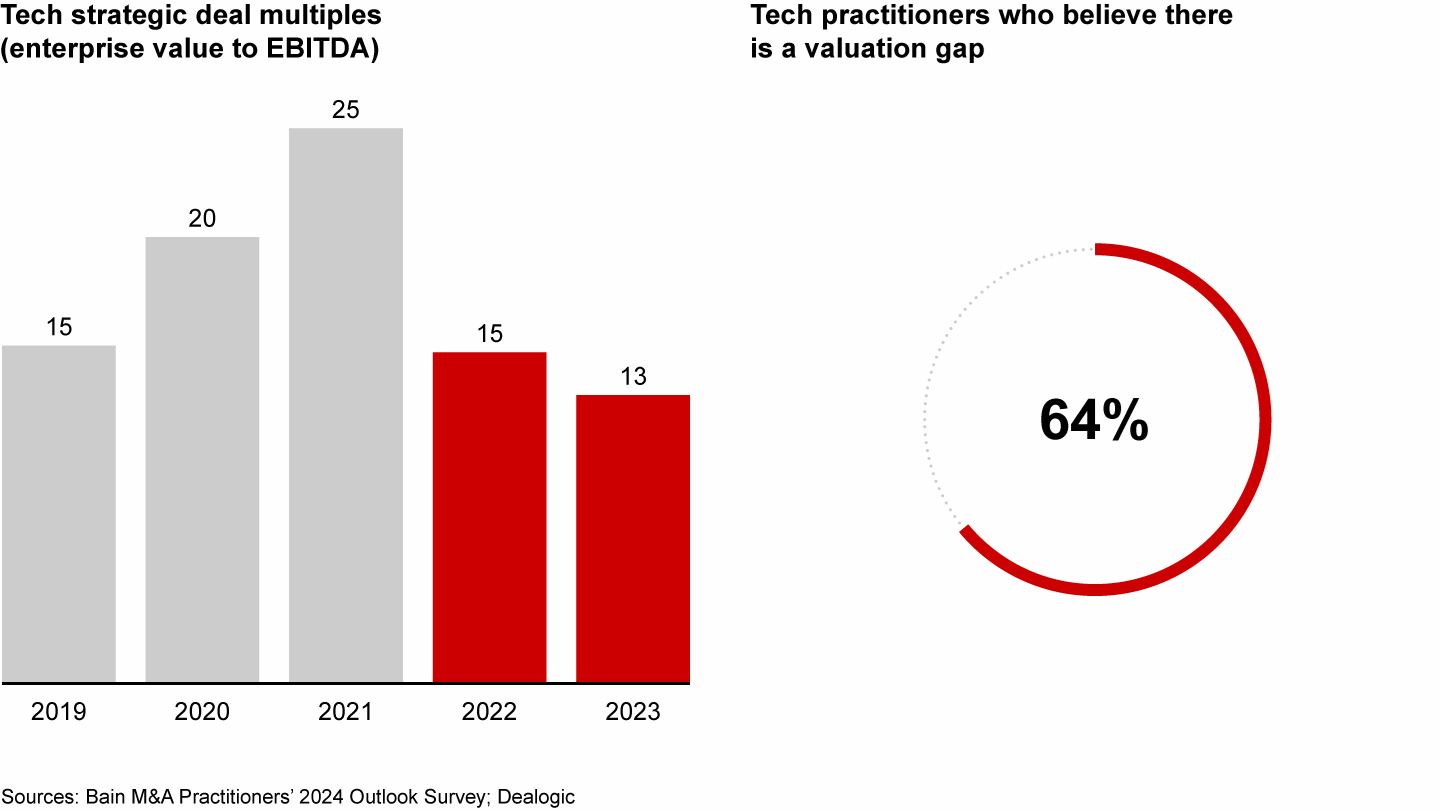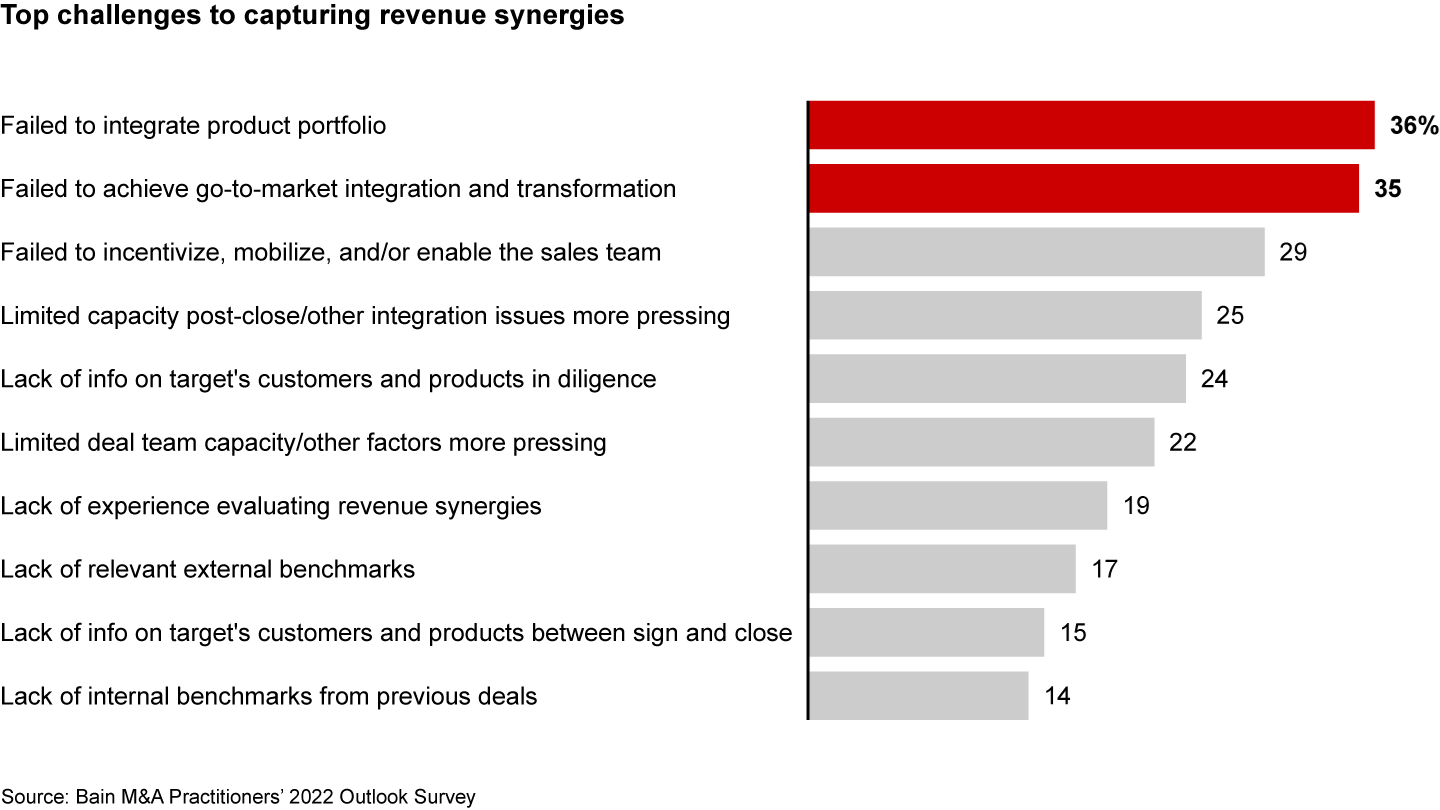M&A Report

At a Glance
- Product synergies are often hypothesized but not valued, therefore they don’t get the investment rigor and focus needed to make them a reality.
- Companies no longer have that luxury given the current market environment of high interest rates, a valuation gap, regulatory scrutiny, and intensifying disruptive innovation.
- Bringing product portfolios together will be more important to achieving longer-term value from deals.
This article is part of Bain's 2024 M&A Report.
While many a tech acquisition starts with lofty aspirations for groundbreaking new capabilities and growth that can be unlocked by combining the tech from the target with the acquirer’s portfolio, rarely do these product synergies materialize. Companies may dutifully write product synergies into the deal thesis, but they then typically fail to provide the funding and rigorous planning required to make them happen.
Until now, companies could make acquisitions succeed with base business growth and cost synergies alone. But in today’s market, they no longer have that luxury. Times are tough for acquirers. Higher interest rates make deals more expensive. Macroeconomic uncertainty endures. And regulatory scrutiny lengthens pre-close timelines and threatens the possibility that deals will even close.
Yet, in this environment, M&A has never been more important for a technology company’s strategy, according to our recent M&A Practitioners’ Survey. Technology innovation still roars ahead at its rapid pace, with artificial intelligence (AI) reaching an inflection point in 2023, which raises the stakes for companies to expand and reinvent their offerings as data becomes the new business currency. And despite the AI-dominated headlines, cybersecurity, the metaverse, the intelligent edge, and other disruptive trends also are creating a need for companies to innovate—or else risk being left behind. For many in the industry, it’s time to reset and reinvent via M&A.
But these are not the best of times for tech dealmakers. Overall, volume dropped 26% in the first 10 months of 2023, and value was down by 59%—more than almost any other major industry. Despite the macroeconomic challenges, however, deals were still getting done, more than 4,100 during the first nine months of the year. While 31 of those deals were valued in excess of $1 billion, the bulk were smaller scope deals aimed at expanding into new market segments or accessing new capabilities.
Companies that move with speed and boldness can still find good opportunities. In fact, there are signs that the lackluster deal activity could improve. In 2023, valuations dropped by roughly 45% from post-pandemic record highs to a median 13 times enterprise value–to–EBITDA multiple (see Figure 1). The valuation gap between what sellers need and what buyers are willing to pay may be narrowing. In our survey of tech industry practitioners, 42% saw an easing of the valuation gap as key to unlocking deal flow, and roughly 40% expect the gap will decrease next year.
Despite declining tech valuations, practitioners still believe there is a gap in buyer/seller expectations; resolving this will be critical to unlocking deal flow in 2024


This comes at a time when growth is riskier and more certainty and early planning is needed to turn a deal strategy into reality. In our 2022 report, we wrote about the importance of realizing immediate post-close revenue synergies through focused go-to-market (GTM) efforts. Now, those that get deals through will also need to focus on bringing the product portfolios together, which will be increasingly essential to achieving longer-term value from the deal. And that will be even more critical for success among the growing number of acquisitions for which AI is a key part of the deal thesis. The deal multiples are higher, the technology is comparatively unproven, and the value comes from unifying data sets and reinventing offerings to capture new opportunities for product or service differentiation. Companies need to plan their long-term strategy for putting those technologies together to power the AI use case or create a bigger and better data set.
In the Bain M&A Practitioners’ 2022 Outlook Survey, we asked about the difficulties in achieving revenue synergies. Respondents told us that a failure to integrate the product portfolio was cited as the most common reason why companies were unable to capture revenue synergies (see Figure 2). While many dealmakers have perfected their ability to estimate near-term revenue synergies, they often have massive plugs in the model for these vital longer-term product synergies, with little view into how to actually achieve them. They now need to devote equal energy to product integration, the longest term (and therefore the least certain) of all synergy drivers. That means strategically bringing offers together, developing differentiated new customer value propositions, and building integrations or unified platforms that, in turn, enable the longer-term revenue synergies.
Ineffective product portfolio integration was the most common reason cited for a failure to capture revenue synergies


What does good look like? Consider how Adobe’s multiple acquisitions have helped expand its cloud platforms, such as Marketo, which in 2018 became part of its Experience Cloud. Adobe puts emphasis on product integration to realize a seamless “better together” user experience, one that it has turbocharged over the past year by embedding AI-enabled features into many of its well-known design tools.
Why is this so hard? We see three common oversights.
The first hurdle involves keeping customer intimacy top of mind throughout the deal cycle. In diligence, companies typically don’t use a deep customer lens when developing the combined offers and use cases. Then, post-announcement, there’s a lack of proactive customer communication about the combined company vision—something that can result in competitive reversals and churn. Companies need to perform diligence with the objective of learning what customers actually want (joint offers or compelling use cases, for example) before defining a high-level roadmap of priorities and related investments for potential synergy product offers. This needs to be nailed down before closing the deal. And companies need to make it a must-have deliverable on day one to communicate the near-term and long-term priorities externally. The sooner they can make commitments, the sooner they can fend off competitors who are trying to sow uncertainty into the minds of customers.
The second challenge centers on the need to align and motivate key talent. A product vision and strategy require agreements across stakeholders from different functions within both organizations. That’s difficult to manage in early days. But mismanaging this process can cause critical leadership to depart, jeopardizing the integration. Building early alignment on the end product vision and what it will take to get there (again, grounded in a compelling “better together” customer value proposition) can inspire talent.
The best companies pull forward strategic product planning with a dedicated cross-functional team as part of the integration management office. They help clarify the early development work needed to support day-one joint offers as well as the long pole development that underpins broader platform plays to hit the ground running. Product planning teams must move in lockstep with GTM planning teams to ensure that future products/bundles are priced and packaged to resonate in the market and that sales teams are retrained and the technical support is in place to sell the new joint value proposition.
As a big part of the talent equation, the best acquirers take a tailored approach for different technical talent populations, using both financial and nonfinancial levers. They host joint sessions with key product leaders, clearly and quickly answering the “what’s in it for me” basics and addressing the inevitable “elephant in the room” issue about how teams will come together to support the longer-term product strategy and vision. Also important is tailoring the cultural integration approach to specific talent subcultures.
Finally, technology company acquirers face the challenge of refocusing their energy and investment on creating long-term value. Amid competing priorities and operational fire drills, it’s easy to deprioritize the critical decisions and investments that will spur long-term value. Without a clear integration thesis, organizational energy and corresponding investments may be misplaced. This is unsurprising. There are competing priorities: How much do we invest in the base business, and how much do we invest to generate the true synergies that are the basis of the deal? Achieving both requires a systematic and data-driven approach—something that’s much easier to say than do. At the best companies, every investment dollar follows strategy. That means establishing clarity on R&D spending—namely, ring-fencing incremental investments, defining criteria for evaluating synergy investment opportunities, and establishing a centralized mechanism for strategically allocating funds based on business cases.
Too many companies stumble in their product integration planning. The best acquirers do these three things right to put themselves on the best path to success from the onset.